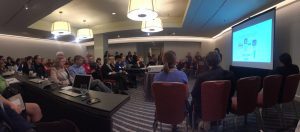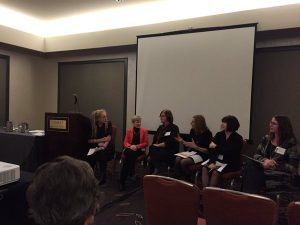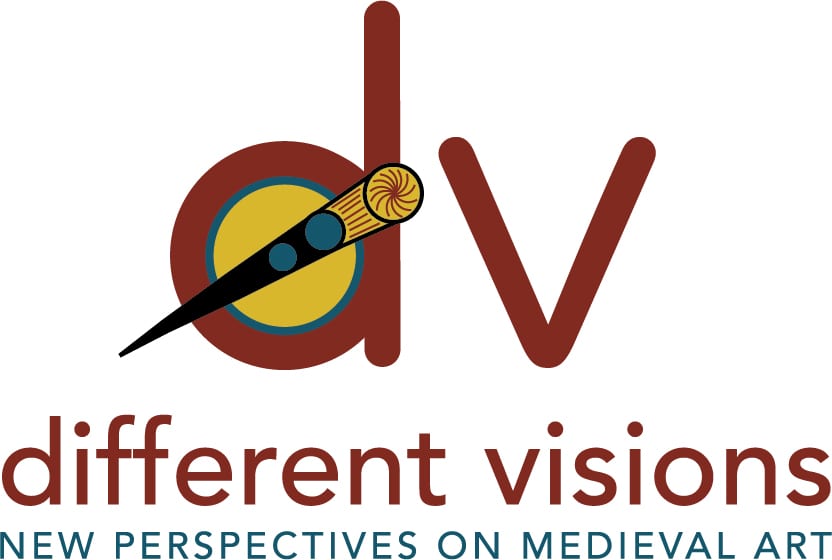
The scene at “Interactive,” a session in the Digital Humanities strand
“This is not your grandfather’s MAA,” Lisa Fagin Davis assured the crowd, to a smattering of applause and some laughter. Maybe not, but as a first-time attendee I was definitely struck by the peculiar coexistence of old and new, traditional and nontraditional, at this storied conference. The 91st Annual Meeting addressed this tension in several ways, the most prominent being the important motion to pass a Statement on Diversity and Academic Freedom. Less visible, perhaps simply by virtue of our fewer numbers, was the younger generation of medievalists: the students, graduate students, and early career researchers, who, often for reasons of cost prohibitiveness, are unable to attend big conferences. But the MAA is making strides in this area and will hopefully continue their support. In this regard, Stephanie Chapman and the MAA Graduate Student Committee, as well as all those involved in the Mentorship Program, must be commended for their work to encourage student research and foster dialogue between scholars at every stage of their career.
Traditional plenaries were enlivened by both the quality of scholarship and its delivery. Will Noel presented a kind of call-to-arms for digital humanists everywhere, exhorting us not only to make all our data freely accessible, but to make it promiscuous. Sharing is caring, after all! And not many speakers can hold the attention of a ballroom full of thirsty scholars while the promise of food and drink at the incomparable Isabella Stewart Gardner Museum awaits; Robin Fleming is one of them. Her investigation into the ecological impact of the Romans in Britain focused mainly on material culture, but also contained many unexpected (and delightful) details; for instance, that the soundscape of post-Roman Britain included a survival from the imperial period in the form of the rooster’s morning call.

Roundtable discussion after the “Ruins” session.
Elsewhere, the nontraditional nature of some sessions contributed to their overall successes. One example was part of the WorksUnfinished strand, called Ruins. Five scholars presented short papers on a wide range of topics, from Arthur Kingsley Porter’s travels with his wife, Lucy, among the bombed out churches of France after World War I, to the mutilation and fragmentation of lavishly illuminated Venetian mariegole for the purpose of sale on the nineteenth-century art market.
Organizer: Karen Overbey (Tufts University)
Catherine E. Karkov (University of Leeds), “What the Ruins Saw”
Kathryn Brush (University of Western Ontario), “Imag(in)ing the Middle Ages in Ruins: Arthur Kingsley Porter and Lucy Wallace Porter in the régions dévastées, 1918-19”
Lyle Humphrey (North Carolina Museum of Art), “Pages Torn from the Record of Venetian Art: Venetian Mariegole through the Centuries”
Maggie M. Williams (William Paterson University, Material Collective), “Bombs, Bulldozers, and ‘Simpletons’”
Susan L. Ward (Rhode Island School of Design), “The Walls of Medieval Provins: Ruins Reviewed”
This was followed by a lively discussion, first between the speakers, and afterwards between the speakers and audience, about the “spectacle of ruins” and the unnerving frisson stimulated by buildings and objects whose very existence, however picturesque, often still speak to the contemporary viewer of a very real history of violence and suffering.
A similarly successful, if unconventional, session was the fourth in the particularly rich Digital Humanities strand, and appropriately titled Interactive. Its unique format was apparent from the moment we entered the room and were presented not with the usual sea of empty chairs set up before a podium, but instead with a horseshoe of slim tables upon which a dozen or so speakers were fiddling with their laptops. The structure of the session itself also rejected norms, instead privileging discussion and dialogue above the standard format of papers followed by questions. Representatives from eight different projects received three minutes each to pitch the scope, goals, findings, successes, and struggles of their respective ventures.
Emily C. Francomano (Georgetown University), Heather Bamford (George Washington University), Yoel Castillo Botello (Georgetown University), and Michael Ferreira (Georgetown University), “The Digital Libro Project”
Robin Wharton (Georgia State University) and Elon Lang (University of Texas at Austin), “Transforming Texts and Textual Scholarship in the Hoccleve Archive”
Francesco Marco Aresu (Wesleyan University) and Matthew Collins (Harvard University), “Digitally Visualizing a Bibliography of Dante’s Commedia”
Elizabeth K. Hebbard (Yale University), “Manuscript Binding Waste in Beinecke Incunabula”
Dawn Marie Hayes (Montclair State University) and Joseph Patrick Hayes (Independent Scholar), “Sicilia Normanna: A Digital Conservation Project for Sicily’s Norman Past”
Toby Burrows (King’s College London), “Visualizing and Modeling the History of Manuscript Collections: New Digital Approaches”
Lynn Ransom (Schoenberg Institute for Manuscript Studies), “The New Schoenberg Database of Manuscripts: A Research Tool for Tracking the Current and Historic Locations of the World’s Manuscript Books”
Michelle R. Warren (Dartmouth College), “Remix the Manuscript: A Chronicle of Digital Experiments”
After the speakers assumed a spot around the inside of the horseshoe, audience members were encouraged to circulate, ask questions, and explore models and maps in more detail. Chair William Stoneman specifically called on us to seek out not only the scholars whose research spoke to our own interests, but also those whose work was outside of our academic comfort zones. The result was at once organized chaos and a resounding success.
This kind of experimentation is something that I hope the MAA will support in the future. In the drive to further involve graduate students and early career researchers, in the fostering of dialogue between junior and senior colleagues, and in the structuring of conference events themselves, inclusivity and interactivity should always be guiding principles.
Emily Savage is in the third year of her PhD in Art History at the University of St Andrews, Scotland. Her thesis examines issues of gender, viewership, and reception in late medieval English art. At this year’s MAA conference she was awarded Best Graduate Student Paper for her paper “‘i pray you remember your suster elizabeth’: Fitzwilliam MS 48 and Its Patrons.” This spring, she is co-organizing a conference for postgraduate and early career researchers on the theme of recycling in medieval art; Re/Generate: Materiality and the Afterlives of Things in the Middle Ages will take place in St Andrews on May 6-7.
